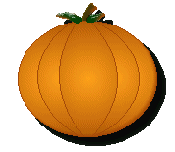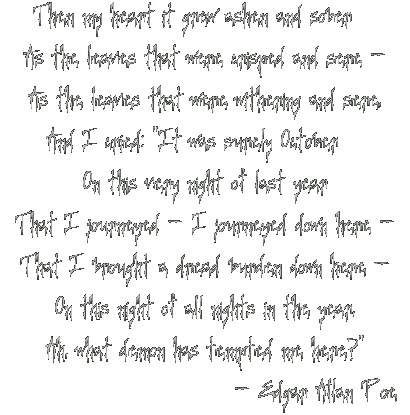
Halloween or "Samhain" means "End of Summer" and falls on October 31 of the year. Its historical origin is The Feast of the Dead in Celtic lands. The Celts were a people of the northern climes of Ireland and Britian. The Druids were a religous sect of ancient Celtic times. The observances of Halloween are believed to have originated with the ancient Celts and Druids, who believed that on that evening, the lord of the dead called forth hosts of evil spirits. Samhain is the time the veil between the worlds of the living and the dead are very thin, souls that are leaving this physical plane can pass out and souls that are reincarnating can pass in. Most Halloween customs can be traced back to the Celts, who believed that on October 31, the last evening of the year, the spirits of those who had died in the past year revisited their earthly bound homes and wandered about looking for bodies to inhabit. The Druids lit great fires on Halloween, apparently for the purpose of warding off all these spirits. The tradition of lighting fires on Halloween survived until modern times in Scotland and Wales. To frighten the spirits off, the Celts also dressed as hobgoblins, witches, or demons and raised a ruckus. Many Druids prepared a Feast of the Dead on Samhain night to leave offerings of food and drink for the spirits. The custom of trick or treat also stems from an Old English practice in which children went from door to door begging "soul cakes" to feed the wandering spirits. After the Romans conquered Britain, they added to Halloween features of the Roman harvest festival held on November 1 in honor of Pomona, the goddess of the fruit of trees. Traces of the Roman harvest festival survive in the Halloween custom, mostly prevalent in the United States and Great Britain, of playing games involving fruit, such as bobbing for apples in a tub of water. They also used hollowed-out pumpkins carved to resemble horrible faces and lit candles that were placed inside to scare off evil spirits. Samhain was a time to reflect on the death and decay promised by shorter days and colder temperatures. It was time to reflect on mortality and examine the portents of the future.  The music is a piece called "Bard Dance" by Enya. The Bard in ancient Celtic times was a man of great importance. His foremost function was in the praise of his king. He also entertained the assembly, sometimes in eulogy, sometimes in satire. Together with the Druid, Warrior and Silversmith, he represents the image of the ancient Celt. Halloween LinksCeltic Origins of Halloween | Ghosts on All Hallows Eve | Halloween Home |Nightmares in Dreamland | Poe's Ocean of the Night | The Bell Witch | The Graveyard | Vampires: Children of the Night | The Mummy of Seven Stars Site LinksHomeSite Map Email at: dh @ naturehaven.com (take out the spaces and this email address will work)  |

